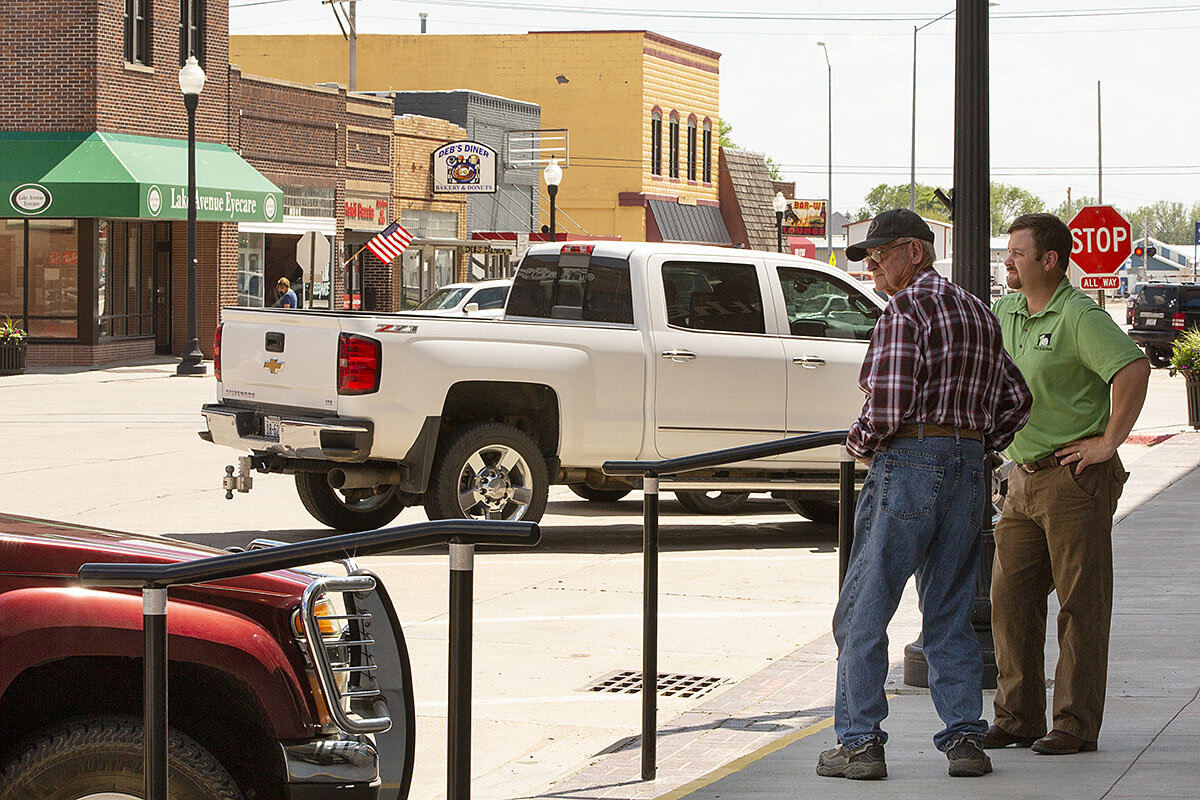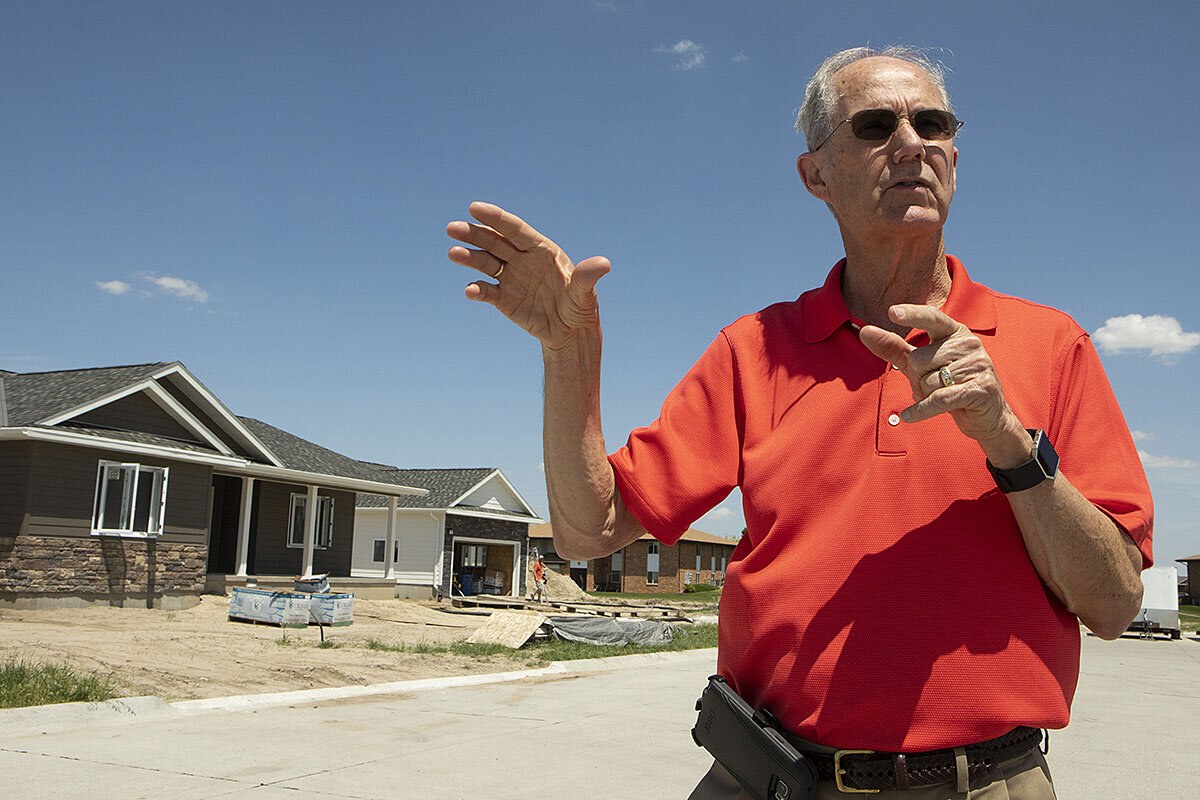Rural America faces housing shortage. How one town is addressing it.
Loading...
| Gothenburg, Neb.
In one unfinished house of this cul-de-sac, the drywall is so new you can still smell the joint compound. In another, a carpenter works on beveling the counter of the kitchen island.
“We were desperate,” says Verlin Janssen, a city councilman for Gothenburg, of the mini building boom. There was so little available housing in this community of 3,448 that nurses, factory workers, managers, and others were turning down job offers to relocate here because they couldn’t find houses to live in.
It may be hard to believe, given the region’s overall population decline, cheap labor, and abundant land, but parts of rural America are struggling with a housing shortage. It affects everyone from low-income families to midlevel professionals. Even executives of hospitals and banks have to consider whether there are appropriate homes for them – or places to rent while they build a home – when they contemplate a move to rural areas.
Why We Wrote This
Mention a housing shortage, and we’re likely to think of challenges in New York or San Francisco. Our writer on the farm beat found it’s just as big an issue on the wide-open Plains.
Fortunately, in the past year, the plight of these home-starved communities has gained national attention and broad bipartisan agreement that something should be done, even if Democrats and Republicans disagree on solutions.
“I see more attention to housing policy at the federal and presidential level in the last six months than I've seen cumulatively my whole career,” says David Lipsetz, CEO of the Housing Assistance Council, a Washington-based nonprofit focused on rural housing and communities. In the last presidential election, when the Democratic platform made a single mention of rural housing, “my heart started beating: ‘Oh my gosh, somebody mentioned housing!’” he says. “And now it's like every candidate out there has programs that they're pushing that are so detailed I have to study up to figure out what they're talking about. That gives me great hope.”
Solutions are complicated because housing policy is complex and rural America itself is so diverse.
In vast stretches of countryside, small isolated communities continue a decline that’s gone on 80 years or more and may be accelerating. In addition to all the usual forces of rural depopulation – such as the departure of young people for better educational opportunities, the disappearance or relocation of factories to bigger places, the ongoing consolidation of agriculture into bigger and fewer farms – these rural counties face a demographic threat. They’re increasingly unable to offset outmigration with modest population growth because births no longer outnumber deaths in these aging centers, writes Kenneth Johnson, a demographer at the University of New Hampshire in Durham, in a recent report. “Nonmetropolitan counties are experiencing absolute population decline for the first time in America’s history.”
But it’s not bleak for all of rural America. Counties on the edge of metro areas, those with amenities such as rural colleges or tourist attractions like mountains or lakes, and those communities that consolidate the commerce of faltering small towns into a single location are stable or growing. And it’s in these areas that the shortage of homes is focused.
Some of the biggest challenges involve low-income rental housing.
That’s because 50-year federal loans made to build rental complexes in rural America are starting to mature. And when they mature, landlords of those complexes are no longer bound by federal rules mandating that they stay low-rent, and tenants no longer receive federal assistance with their rent. Then one of two things happens: Landlords either jack up the rent (if they’re in a thriving area) or they close the facility, because they can’t afford to run it when their tenants lose federal assistance.
It’s a problem that will build in coming years, ultimately affecting more than 415,000 affordable homes in rural America.
Why rents surged in one Kentucky county
And the problem isn’t limited to subsidized units. Already, 1 in 4 rural renters spends more than half his or her income on housing, according to the Urban Institute. In a 2018 study, the Washington-based think tank found more than 150 rural counties with younger, poorer, more diverse, and yet growing populations where all rental housing is in short supply. Some of these are because of special situations.
In one eastern Kentucky county, rents are on the rise because the local medical facility has a large intern program that brings in medical students. But because of the mountainous terrain, space is limited to build more housing, says Corianne Scally, a researcher at the Urban Institute. In touristed rural areas, outsiders snap up second homes, which raises the price of land and homes, sometimes beyond what locals can afford.
Then there’s the lack of contractors and the cost of building materials, often trucked in from urban areas, which ironically make it more expensive to build in rural Nebraska than in Omaha.
“I have five critical access hospitals in my little legislative district,” says Nebraska state Sen. Matt Williams, whose hometown is Gothenburg. “Every one of them is shorthanded of workforce right now.” One reason, he says, is the lack of housing for workers.
Two years ago, he got a bill passed that used $8 million in state funds to offer matching grants to Nebraska communities if they would build homes. The program got twice the number of applicants than it had funding for. “We were just overwhelmed,” Senator Williams says. The state has gone on this past legislative year to pass tax breaks for building homes in rural areas.
Rising demand, thanks to Doritos
Gothenburg didn’t wait for state or federal help. Home to a Frito-Lay plant – “If you eat a Dorito, Tostito or Frito west of the Mississippi River, it most likely came from the Gothenburg facility,” the community proudly proclaims – the town wasn’t bringing in enough talent.
“We were seeing our local businesses lose out on all of the candidates that wanted to come to work in our community but just couldn't find housing,” says Nate Wyatt, president of the Gothenburg Improvement Company, the local economic development group.
The GIC has worked hard to bring companies to town, including the Frito-Lay plant. So the group approached a contractor with the proposition that it would make up for any losses if he would build six homes in town. Those houses were snapped up, and none of the 20 or so local residents who signed loan guarantees up to $10,000 has had to write a check.
Now, the city’s community redevelopment authority has used a similar guarantee to get two contractors to build seven two- and three-bedroom homes in the cul-de-sac, which are now rising from their foundations. The cost: about $240,000 each. Three are already sold, according to Mr. Wyatt, and another two are spoken for.
The city dipped deep into its budget to extend Avenue J several blocks to give access to the cul-de-sac. “We’re not going to make any money on this,” says Mr. Janssen, the city councilman. But already, he’s looking longingly at the acreage across the street as a place to put in even more homes.
Some progress for rural homes at the federal level has come at the regulatory level, where the Trump administration is pushing the federally sponsored home mortgage guarantors Fannie Mae and Freddie Mac to guarantee more rural rental projects. And states may come up with more incentives.
But the biggest progress will come only when local communities have the local organizations and know-how to apply for and manage the state and federal resources that will be made available, says Mr. Lipsetz of the Housing Assistance Council.
And a little of Gothenburg’s derring-do might not hurt.








